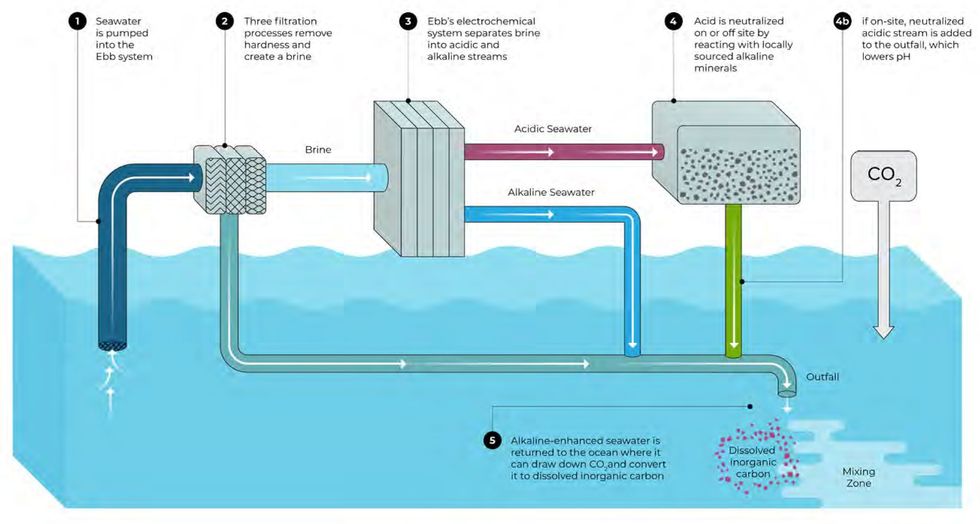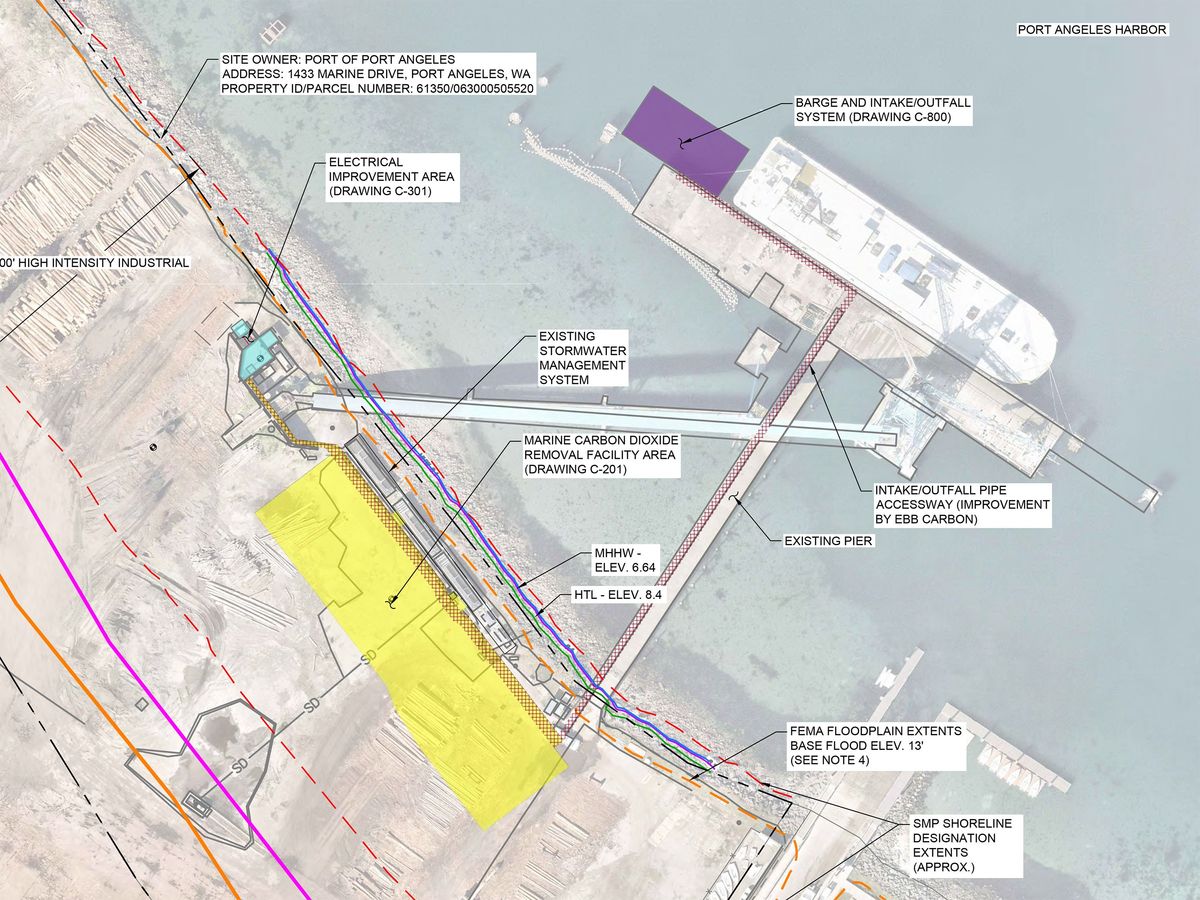California startup Ebb Carbon could start using seawater to remove hundreds of tonnes of carbon dioxide from the air as soon as this year, according to plans and permit applications filed with the city of Port Angeles in Washington state.
The carbon dioxide removal (CDR) pilot plant, code-named Project Macoma and not previously reported, will pump hundreds of thousands of liters of seawater every day into a series of tanks and shipping containers on shore. There, an electrochemical process will split the water into acidic and alkaline streams. The acidic stream will be either neutralized or shipped out in trucks, while the alkaline stream will be returned to the ocean via a floating barge.
That alkaline outflow would mix with C02 in the ambient seawater to create bicarbonate, which is a stable way to store carbon. With more CO2 locked away, the ocean would slowly seek equilibrium by drawing down CO2 gas from the air. In this way, the company claims it will remove at least 500 tonnes of CO2 per year from the atmosphere.
While that’s literally a drop in the ocean compared to the more than 2.5 trillion tonnes of excess carbon dioxide that humanity has released into the atmosphere since the Industrial Revolution, it’s five times the capacity of the largest marine CDR experiments to date. Ebb is currently testing a 100-tonne system at the Pacific Northwest National Laboratory (PNNL) in nearby Sequim, while rival startups Captura and Equatic have similarly sized electrochemical plants at the Port of Los Angeles in California. All plan to sell, or have already presold, carbon-removal credits from future facilities.
“Findings from this small-scale pilot project would help support future commercial deployments at other locations throughout the world in order to help mitigate the effects of climate change,” Ebb wrote in an environmental checklist document for the city of Port Angeles. To ensure the energy-intensive electrochemical process remains carbon negative, Ebb chose a location that was powered primarily by renewable energy (in this case, hydropower).
Another clue to why California-based Ebb is operating in far-off Washington could be in the project’s name: Macoma is a genus of seawater clams, including many native to the Pacific Northwest. As well as warming the planet, carbon dioxide has been acidifying the oceans and decreasing the carbonate ions that many clams and oysters need to build their shells.
Washington’s shellfish aquaculture industry employs thousands of people and is worth hundreds of millions of dollars. The alkaline stream that Ebb returns to the sea should reduce acidity locally and could boost the growth of marine organisms. The company is actively seeking shellfish nurseries and hatcheries to partner with on future projects.
The Challenges of Scaling Up Marine Geoengineering
But the planned pilot is a complex endeavor. Ebb’s facility, which will eventually run day and night, will generate up to 20 liters a minute of hydrogen as a by-product. In a full-scale plant, this might have commercial value as part of the burgeoning green hydrogen economy. At Project Macoma, it will just be “diluted below lower explosive limits” and vented to the atmosphere.

A bigger challenge is what to do with the leftover acidic water. The filings suggest that Ebb might separate hydrochloric acid from the stream and sell it for use in cement manufacture or laboratory research. Another option is to neutralize the acid on site using alkaline minerals such as olivine or basalt. The neutralized water stream would then be returned to the ocean.
Many ocean scientists remain deeply skeptical of marine geoengineering. At a meeting of the International Maritime Organization last October, dozens of governments called for deferring marine geoengineering, including ocean-alkalinity enhancement, over concerns about “deleterious effects that are widespread, long-lasting, or severe.”
Brendan Carter is a chemical oceanographer with the U.S. National Oceanic and Atmospheric Administration (NOAA) who is working on Ebb’s smaller pilot at Sequim. “The initial experiments are demonstrating that the fundamental chemistry is working the way we would expect,” he tells IEEE Spectrum. “There are also experiments looking at the impacts on marine organisms, but it’s a pretty long road.” For instance, the PNNL system has still not actually released any alkaline water back into Sequim Bay, says Carter, out of an abundance of caution.
Carter says that all the electrochemical CDR startups are still at an early stage, and will face big challenges when scaling up—both in sourcing enough renewable electricity for their energy-intensive operations and in public engagement.
“Generally speaking, the local community seems supportive today but once we’re talking about scaling up, then it’s like 60 fire hoses of the product going nonstop,” he says. “We need to make sure we’ve got people fully briefed about what to expect.”
Last October, dozens of governments called for deferring marine geoengineering, including ocean-alkalinity enhancement, over concerns about “deleterious effects that are widespread, long-lasting, or severe.”
According to the documents filed with Port Angeles, Ebb’s technology includes comprehensive monitoring, modeling, and reporting systems to track the chemistry of the seawater and health of the marine ecosystem, from tiny plankton, seaweed, and salmon to the largest orcas and humpback whales. During the first six months of Project Macoma’s operation, no alkaline water will be released as the company collects baseline data and tests safety controls. When CDR does commence, the company writes that it will immediately halt operations if it detects any problems.
Ebb Carbon supplied Spectrum with a statement about Project Macoma. It reads: “Ebb has been demonstrating our climate and ocean-health technology in partnership with the PNNL in Sequim since last August. We’re pleased with the progress of that site and are exploring a pilot facility in Port Angeles, Washington. We’ve been working with community stakeholders to gather feedback about this potential site, and will continue to do so as we formalize our plans. We will share more details as we have them.”
Port Angeles seems convinced so far and issued a finding earlier this month that the project “will not have a probable significant adverse impact on the environment.” Further permits will be required from city, state, and federal agencies, wrote the company in its filings, including from the U.S. Army Corps of Engineers and the U.S. Fish and Wildlife Service. Ebb wrote that construction could take just four months, with initial operations beginning this summer.
Even if Ebb does get going that quickly, it might not hold the title of the largest marine CDR plant for long. Captura wants to add a 1,000-tonne facility to a natural-gas processing plant on the west coast of Norway, and Equatic estimates that a plant in Singapore will be drawing down 3,650 tonnes of CO2 annually, starting next year.
The Department of Energy is also currently soliciting requests for a US $100 million Carbon Shot program that will fund up to 20 pilot tests for carbon dioxide removal and storage in geological, biological, and ocean reservoirs.
It seems that despite uncertainty among scientists, the race to decarbonize the air and de-acidify the oceans is on.
- Here’s How We Could Brighten Clouds to Cool the Earth ›
- Climate Expert: Stop Talking About "Geoengineering" ›
Mark Harris is an investigative science and technology reporter based in Seattle, with a particular interest in robotics, transportation, green technologies, and medical devices. He’s on Twitter at @meharris and email at mark(at)meharris(dot)com. Email or DM for Signal number for sensitive/encrypted messaging.



